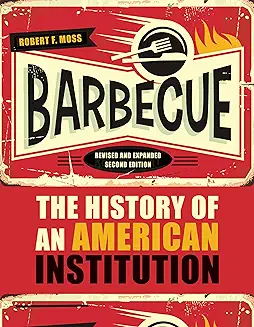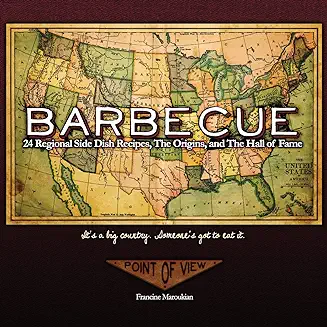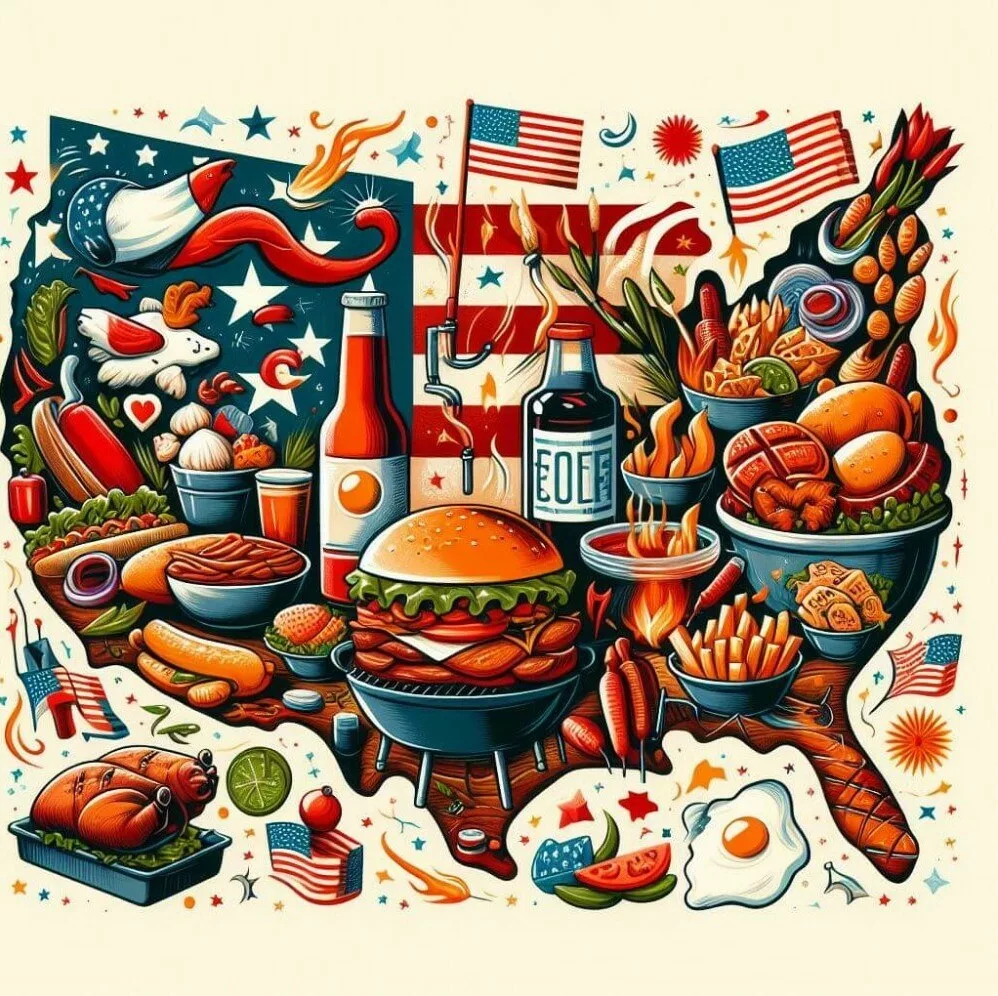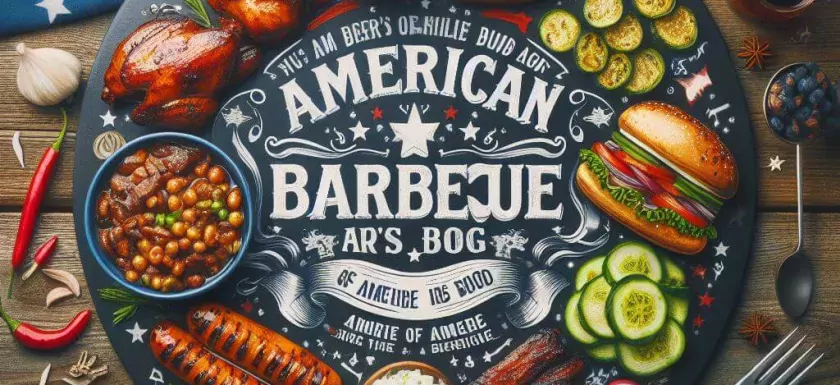Imagine the tantalizing aroma of smoked meat wafting through the air !’ it’s no wonder that American barbecue has captivated the hearts and palates of millions. But where did this culinary tradition begin? I’m going to take you on a journey back to its roots, discussing the origins of American barbecue: A rich history of cultural cooking techniques and taste.

The term ‘barbecue’ might seem as American as apple pie, but it actually traces back to Caribbean origins, thanks to the cultural exchange initiated by Spanish explorers. These explorers encountered Indigenous peoples in the Caribbean who were skilled in the art of cooking meat over an indirect flame, using a method called barbacoa.
This technique didn’t just stay island-bound for long. In 1540, the Chickasaw tribe, residing in present-day Mississippi, were documented to have adopted the barbacoa method to cook pork. This event marks a significant moment in the morphing of the barbecue tradition into what would become a cornerstone of American food culture.
The Deep Roots of Barbecue Culture in the Southern Colonies
As the popularity of barbecue spread, it took deep root in the Southern colonies. This wasn’t just about a new way to cook meat; it reflected the interweaving of diverse cultures and the gradual evolution of regional culinary practices. Pork reigned supreme in the South, not only for its taste but also due to strategic reasons. The preference for pork in the South was driven by its affordability and low-maintenance nature, making it accessible to all economic backgrounds.
As we approach the next section, I’m here to guide you through how this preferred protein found its way into the heart of Southern barbecue and how it helped shape regional barbecue styles. This isn’t merely a story of taste; it is a narrative of economic decisions, cultural adaptations, and the ingenuity of pitmasters past and present.
Pork, Preferences, and Pitmasters: The Rise of Southern Barbecue
You might wonder why pork, not beef or chicken, is the poster child for Southern barbecue. I’m here to help you with that history lesson. The preference for pork in Southern BBQ isn’t just about taste; it’s rooted in practicality. Back then, pork was the more affordable and low-maintenance choice for farmers in the South. Pigs required less attention and resources compared to cattle, making them an economical choice.
The Origins of American Barbecue – Vast Plantations, Small Scale Farms and Razorback Hogs!
I want to paint a picture of the South during the colonial times. Imagine vast plantations and small-scale farms, where razorback hogs roamed free, foraging for their own food. These feral pigs were resilient and could thrive in the Southern wilds without much care. When the time came, they could easily be caught and prepared for cooking, making them a convenient source of meat.

As barbecue traditions took hold, the pitmasters of yore played a crucial role in elevating pork’s status. They mastered the art of cooking meat low and slow over indirect flames, a technique that turns tougher cuts of pork into succulent and tender feasts. The lengthy cooking times were actually a social event, where communities would gather and bond over the shared experience, slowly turning this cooking style into a cultural phenomenon.
But it was more than just cooking meat; it was a blend of skill, patience, and tradition that produced flavours which have since become a hallmark of Southern hospitality. In BBQ circles today, the pitmaster is still regarded with a mix of reverence and anticipation, often becoming a local celebrity.
You can always adjust your approach down the road, and that’s exactly what the South did. With the passage of time, Southern barbecue has evolved, but it retains the soul of its humble origins. By and large, it stands as a testament to the ingenuity of early Southern cooks who used what they had to create a tradition that would last generations.
Savoring the Smoky Spectrum: Understanding the Four Distinct Styles
Now, diving straight into the heart of American barbecue, you’re going to find out about the four quintessential styles that define this culinary tradition. Each style is as unique as the region from which it originates, and together, they paint a smoky spectrum of flavours across the barbecue belt.
Starting with Caroline barbecue, it’s all about the tang. This style was heavily influenced by British colonists, who preferred a sharp, vinegar-based sauce. North Carolina takes this tradition seriously, typically serving pulled pork doused with a peppery vinegar sauce that’ll wake up your taste buds.

Then there’s South Carolina, and guess what? They’ve added their twist with a golden, mustard-based sauce, a flavour profile influenced by the state’s sizable German immigrant community. It’s bold, it’s different, and it’s a testament to how immigrant influences have blended seamlessly into the fabric of American food culture and the origins of American Barbecue.
Journeying over to Texas, you’ll notice more beef on the menu, thanks to the German immigrants’ preference for this meat. Here, they’ve taken the Carolina way of cooking low and slow and applied it to beef brisket, creating a smoky, delectable icon of Texas barbecue that’s hard to resist.
Next, Memphis barbecue shines with a sweet note. Here, sauces are often tomato-based and sweetened, leveraging the region’s historical access to molasses. Whether it’s ribs or pulled pork, the sauce is generously slathered, creating a finger-licking good experience that Memphis is proud to call its own.
Last, but certainly not least, is Kansas City barbecue, a true melting pot of the East and West styles. Kansas City doesn’t discriminate against any meat or method, allowing the sweet, tangy, and spicy sauces to commingle with a variety of smoked meats. This all-inclusive approach has made Kansas City a hub for those who like a little bit of everything.
This exploration of styles isn’t just for the history books; it’s a living, breathing map of tastes that continue to evolve. In the end, these regional variations aren’t competing—they’re adding chapters to the storied book of barbecue tradition.
Barbecue Beyond Borders: Cultural Impact and Culinary Road Trips
I’m going to let you in on something: American barbecue isn’t just a way to cook food; it’s a cultural phenomenon that ties communities together. This culinary tradition has soared beyond the smoky pits of the South, becoming a vibrant thread woven into the country’s cultural fabric. From addicting TV shows to mouth-watering road trips crisscrossing the ‘Barbecue Belt,’ barbecue has made its mark.
Here’s a thing many people don’t realize: behind every piece of slow-cooked meat is a story of regional pride and tradition. These regional styles are not just about the taste—they’re expressive of the history and communities that created them. In today’s bustling world, where customs fade into memories, American barbecue stands tall as an enduring symbol of gathering, sharing, and indulgence.
It’s also about evolution and inclusivity. As barbecue continues to spread, fusion dishes emerge, melding time-honoured techniques with modern tastes. It’s proof that this culinary tradition is versatile and adaptive, thriving not only within its birthplace but also across an ever-globalizing world.
Global Barbecuing and Its Impact On The Origins of American Barbecue
If you have some interest in expanding your barbecue experience by adding in some recipes and tastes from Global destinations such as New Zealand, South Africa or India, then visit some of our prior blog posts where we share recipes and cooking methods, alternatively drop into our Delicious Recipes Page and take advantage of many of our FREE downloadable recipes made for barbecuing.
Alternatively, If you want to experience the full spectrum of local regional barbecue flavours, and truly experience the origins of American Barbecue then I highly recommend hitting the road. There’s nothing like tasting the tangy, vinegar-based sauces of Carolina in their home setting or uncovering the dense, intoxicating smokiness of Texas-style brisket where it all began.



In Conclusion – Origins of American Barbecue
In closing, I encourage you to not just eat but to savour and respect this rich culinary heritage. Whether you’re firing up your grill or planning your next road trip, remember, American barbecue is more than food—it’s a celebration of heritage, community, and the myriad stories of America itself.


